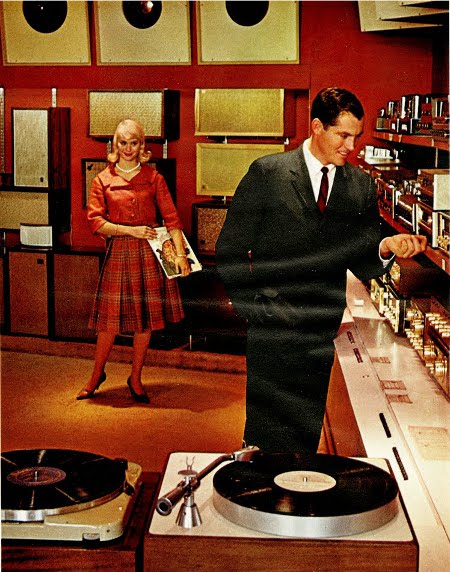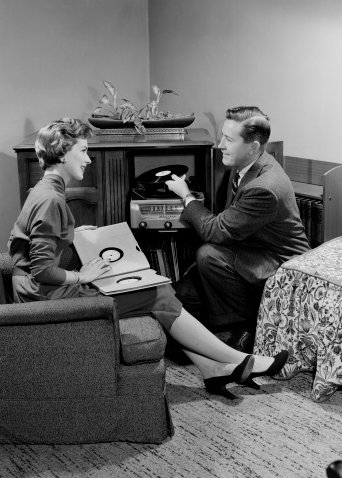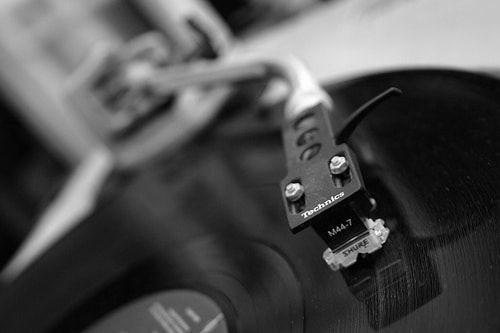
Editor’s note: This is a guest post from Cameron Schaefer.
So, you’ve decided to get into vinyl. Perhaps the story I shared last month about my own journey into record coll... piqued your interest. Maybe you inherited a great collection from a family member or got inspired by the collection of a friend. No matter what your path was to get here, the first hurdle most people must clear is that of buying a turntable. As with any electronic equipment, the options are endless, price range vast, and feature sets diverse. With no past experience the process can be a little intimidating, but fear not. I was in the position of clueless beginner a short time ago and can report back that once you learn a little lingo and make a few decisions regarding your needs and desires, there are a lot of really great turntables out there just waiting to find a cherished place in your home.
Note: This guide is not for those wanting to DJ, scratch, etc. While some of the turntables covered below would work for that sort of thing, it’s a completely different area of expertise. What we’re focusing on is beginner audiophile turntables. “Audiophile” is a fancy way of saying people who are interested in producing the highest quality sound.
Basic Components of a Turntable
While one doesn’t need an engineer’s knowledge of turntable design, it’s good to have a basic understanding of the main components and how they work since they will pop up routinely in discussion. In short, a turntable’s sole purpose is to put a needle on a record to produce music. Seems simple enough, but when you take into account that a single record groove is smaller than the width of a human hair, you start to understand the importance of precision in such an operation. When someone pays $5,000 for a turntable, much of what they’re paying for is nothing more than increased precision and stability. With those two factors in mind, the following are the key components that go into re-creating the sound contained on the record with as much accuracy as possible.
Plinth (Base) – The foundation of the turntable that supports the rest of the components. Generally, the base has feet attached to it to help ensure stability (which is key to good playback). The plinth can be made from a variety of materials including wood, plastic, or metal.
Platter – The rotating component upon which the record rests/spins. In general, the heavier the better (less vibration). It is powered by the motor and generally has a mat that is placed between its surface and that of the record. The mat provides a cushion for the record, provides grip, and also helps with vibration dampening. The speed of the platter must be set to match the cut of the record (33RPM, 45RPM, 78RPM). The vast majority of turntables will play both 33RPM and 45RPM, but one often has to buy a modification kit or buy a separate turntable to play the older 78RPM format.
Tonearm – The arm that swings out over the record and allows the needle to make contact with the vinyl as it spins. The arm is designed not only to get the needle on the record, but also to maintain a consistent sound/speed on both the outer and inner circumference of the record. If the design of the arm is poor it might sound slow on the outer tracks and fast on the inner ones. The cueing device (the part that holds the tonearm) is the mechanism that lifts and lowers the tonearm and is a fairly sophisticated piece of machinery that should be handled with care. The job of the cueing device is to provide smooth initial contact with the record without any lateral movement (so you don’t scratch across your vinyl). The cueing process can be automatic (push start and it does everything by itself) or manual (user places arm over record). Audiophiles tend to prefer manual because there are less parts to disturb the tonearm’s motion.
Cartridge/Stylus – This one can be confusing because a lot of terms here are used interchangeably to mean the same thing when people speak in generalities. A stylus is commonly referred to as a needle, and a cartridge is the housing that supports the stylus. People often use the term cartridge when really they just mean stylus. At any rate,when discussing turntables, the old-hands often say the same thing, “Spend some extra money to get a good cartridge.” Since the cartridge houses the stylus, which is the only part of the turntable actually making contact with each tiny sonic groove on the record, it makes sense that even slight upgrades to this component can make substantial improvements in sound quality. With that said, many turntables offer a high-quality cartridge and stylus as part of their basic package. Just remember, the cartridge should only need to be replaced if you are making specific upgrades or if it is obviously damaged. Your stylus, however, might need to be upgraded due to degradation that may not be visible.
The Endless Quest for Sonic Perfection
People will say that vinyl isn’t as good as digital alternatives because of the multiple points of sound degradation that can occur along the path from the record to the ear of the listener: breakdown of vinyl, needle degradation, equipment quality, receiver quality, speakers, etc. We’re happy to report that they are all correct! There are a lot of possible places where sound quality can leak, but that doesn’t deter us in our effort for a listening experience that is far superior to laptop speakers and iPods when it’s done even halfway well. We’re talking about shifting the focus of the music experience from whatever is on to exactly what you want to be hearing – which is about deep, active listening and enjoyment. Yes, the nicer the quality of all the equipment you get, the more enjoyment you might get out of it at some point. But, there is also something to be said about very basic setups that just produce the sound nicely and allow a delightful experience. It’s a hobby, friends, there is no “finished.”
Buying a New Turntable

While there are many great turntables to be had on the used market, the piece of mind that comes with buying a new turntable and knowing that it has never been touched, dropped, or mishandled is often worth a great deal. Before heading off to your nearest record or electronics store it’s a good idea to have answered on your own, even if loosely, the following questions:
1) Price Range – As with most things in life you get what you pay for. However, the great thing about vinyl is that it can be experienced with abundant pleasure even with a very basic setup. You have to start somewhere and many audiophiles and sound enthusiasts with systems in the tens of thousands of dollars look back fondly at their initial turntable/stereo setups as the birthplace of a lifelong passion.
A few price ranges to be aware of:
Sub-$100: There are a multitude of low-budget turntables that will accomplish the basic tasks of getting needle to record. If you’re looking to dip your toes in the water without a large commitment, one of these might be a good option. However, be aware that with a low-end table you will often be sacrificing a certain amount of sound quality. As we mentioned earlier, it would be a terrible shame to decide the format wasn’t for you simply because much of the magic was being zapped by a poor quality turntable. Additionally, the ability to upgrade individual components is often quite limited with lower-budget tables, meaning if you want to upgrade you’ll likely need to buy a whole new turntable.
$300-$500: This is really the sweet spot for beginner audiophile turntables. The sonic difference between many of the offerings in this price range and that of sub-$100 will be distinct in most cases. Additionally, the turntables in this price range will often be configured to allow for a multitude of performance upgrades for individual components (cartridge, belt, stylus, etc.). A couple of Google searches and you will quickly find that three turntables in this price range continually pop up as leaders in both value and performance, and any of them make a fine first turntable:
$500 and up: Once you venture outside of the beginner audiophile range, the sky is the limit. There are an astonishing number of high-quality turntables with exotic designs, mind-blowing precision, and eye-watering performance. If you plan on venturing into this price range you definitely want to consult the experts at your local electronics shop and do a good amount of research.
2) Features – Today’s turntables offer a wide-variety of features in addition to simply playing the record. Knowing how you’ll be using your turntable and which features are most important will help you narrow down your search.
USB vs. Non-USB: One of the newest features to gain popularity among turntable manufacturers is the addition of a built-in USB port. The USB port allows you to transfer music from your records to your computer where you can then convert it to mp3 format. For people looking to digitize large vinyl collections, specifically old or rare albums not available on mp3, having a USB port may be a priority. A word of caution, however. USB turntables tend to have a poor reputation among audiophiles who assert, often rightly so, that the costs of adding the USB port are often made up for by using lower quality components on the rest of the table. Do your research and listen to as many models as possible to ensure you’re not getting a high-tech dud.
Additionally, although you might think that you really want to get your records converted over to a digital format, there might be something to say for just seeking out better digital alternatives. Most new records sold today come with a download card of the music for the purposes of playing on your digital device (the artists know you want to hear their music beyond your living room). Just note that a concentrated pop or tick from a poor vinyl-to-digital conversion when sent directly through your earbuds will probably alarm any listener and ruin the experience and take the charm right out of all your efforts.
Manual vs. Automatic: As mentioned previously, most higher-end tables utilize a manual cueing system, meaning you (the listener) must physically lift the arm and lower it onto the record and lift it back off as it reaches the end of the side. While this is slightly intimidating for beginners who worry about scratching the vinyl, it really is nothing cosmic and becomes second nature after a few attempts. However, if you’re the type of person that just wants to hit a button and let the turntable do the rest, then an automatic turntable may be for you.
3) Upgradeability – Unless you’re planning on dropping a load of cash right out of the gate, you’ll likely want to upgrade your turntable at some point in the future…assuming of course you get hooked on the whole vinyl experience. With this in mind, it is good to know which components on your prospective turntables are upgradeable. Common upgrades include replacing the cartridge, tonearm, belt (if the turntable is belt-drive), and slip mats. Many lower-end turntables are often constructed in a way that doesn’t allow for individual components to be easily replaced–meaning you’re stuck with the stock components. Of note is that many of the beginner audiophile turntables in the $300-$500 range offer “performance packs” or bundles of component upgrades that can be purchased together to enhance turntable performance.
Note: If you’re looking for more information on specific recommendations and reviews for turntables for beginning vinyl collectors, check out our post: Top 5 Beginner Turntables for Vinyl Enthusiasts.
Questions to Ask When Buying Used

What about buying used? Just like in any used electronics market one must always have the infamous, “Buyer Beware” in the forefront of their mind at all times while searching for used turntables. There are a lot of junk turntables looking for a sucker to take them home. On the flip side, with a good amount of patience, effort, and propensity to ask the right questions, there are also a lot of gems to be found and money to be saved. The following is a list of questions one should always ask when buying a used turntable (some may seem obvious, but you’d be surprised…):
- Does the turntable function properly?
- How long has the seller owned it?
- Was he/she the original owner?
- How many hours of use per week during its lifetime?
- Was it used for DJ-ing/scratching? (if so you might not want it due to heavy wear)
- Does it come with a cartridge and stylus? Are they good?
- If it is a belt-drive is the belt in good condition?
- Does it come with all the original accessories? (i.e. dustcover, slipmat, box, instruction manual)
If the seller can answer all of these questions satisfactorily then chances are high you will be getting a decent turntable. If they can’t or seem to be trying to gloss over certain questions then move on and look elsewhere. Finally, when buying used, especially online, it is always a good idea to have the seller spell out their return policy in writing if they haven’t done so already.
If you are shopping for a higher end turntable and find a used one at an affordable price, remember to price-out all the expected upgrades and fixes. If you’re getting a steal on the price but have to shell out $500 in replacement parts you might be better off looking elsewhere. Similarly, somebody not willing to make all those upgrades might be nearly giving away a turntable that can be made almost new again with a little TLC.
Inspecting a Used Turntable
Rather than re-invent the wheel, this video from DJ Tutor is a good guide for what one should check when inspecting a used turntable. As he mentions, he is specifically discussing theTechnics SL-1200MK2 (probably the most prolific turntable of all-time…and the one I own *blush*), but many of the things he highlights would apply to any turntable.
A Quick Word on Pre-Amps
If you’re like I was (clueless about audio equipment) you’ll ask, “Okay, so once I get this turntable I just plug it into….uh…where do I plug it in?” The answer is, “It depends.” With the exception of a handful of other budget turntables which have a built-in preamp, you will likely need to buy a phono pre-amp. Without a pre-amp, the output from your turntable won’t be strong enough to get picked up by your stereo equipment.
Now, I say you will likely need this because it depends on whether or not your receiver has a phono input. Most of the older receivers included an additional gain and re-equalizer stage that allowed you to directly connect your turntable via a phono input. You can easily determine whether or not your receiver has one; look for PHONO on your source selector switch, and input(s) labeled PHONO on the rear. If it doesn’t have it, you probably need a preamp.
Don’t panic, you can find a decent preamp for around $50 (see here). Like everything else, the sky is the limit in terms of price and quality for preamps as well, but that’s a different post for a different day.
_________________
Cameron Schaefer, pilot and early AoM contributor, has spent the past few years raising his two children with wife Marelize, hacking away at his backyard vegetable garden, knocking out an MBA and most recently venturing deep into the world of vinyl records. Along with his friend Levi, the two recently created Vinyl + Cocktails, a blog where they pair their favorite albums with good cocktails.

You need to be a member of NASTYMIXX to add comments!
Join NASTYMIXX